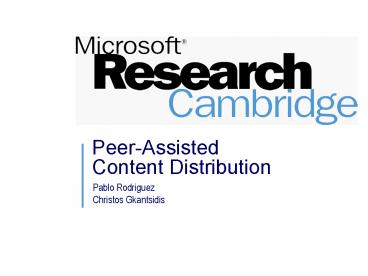PeerAssisted Content Distribution - PowerPoint PPT Presentation
1 / 21
Title:
PeerAssisted Content Distribution
Description:
Movie/Music downloads. PodCasting. Enterprise content distribution. 7. P2P Content Distribution ... Assisted solution for the distribution of legal content ... – PowerPoint PPT presentation
Number of Views:24
Avg rating:3.0/5.0
Title: PeerAssisted Content Distribution
1
Peer-Assisted Content Distribution
- Pablo Rodriguez
- Christos Gkantsidis
2
Traditional Content Distribution
Server Farm
- Often, large content needs to be distributed to
millions of clients - Currently
- Huge server farms
- Infrastructure-based solutions (e.g. Akamai)
- slow, expensive, non scalable
3
Content Distribution Evolution
Layer-7 Switches Satellite CDNs
CDNs Akamai
Disappointment
Hype
P2P
Caching IP Multicast
Enterprise CDNs
Growth
Realism
1999
2000
2001
2002
2003
2004
4
Peer-Assisted Content Distribution
5
Peer-Assisted Content Distribution
Server Farm
- Desktop PCs can help each other!
- Clients become new servers
- Capacity increases with the number of clients
- Limitless scalability and fast speeds at
extremely low cost!!
6
Examples
- Updates/Critical Patches
- Adding large servers and egress capacity to
absorb pick load is quite expensive - Alternative solution is to delay clients
- Patches do not arrive on-time
- Software Distribution
- TV On-Demand. Movie/Music downloads
- PodCasting
- Enterprise content distribution
7
P2P Content Distribution
- Benefits
- Dramatically improves speed
- Limitless scalability
- Minimum server requirements
- Very cheap
- Challenges
- Requires incentives for cooperation
- Hard to ensure end2end full connectivity
- Security
- Manageability
- Lack of locality increases transit costs for ISPs
- Asymmetric links (traffic engineering)
- Variable bandwidth, peers come and go
- Need for more sophisticated distribution
algorithms
8
P2P Swarming
- File is divided into many small pieces for
distribution - Clients request different pieces from the server
or from other clients - Clients become servers for those pieces
downloaded - When all pieces are downloaded, clients can
re-construct the whole file
1
5
6
2
4
3
Rodriguez, Biersack, Infocom00
9
The Challenge
- If there are many users,
- deciding which is the best piece to
- download can be very hard!!
- Incorrect decisions result in low throughput,
nodes not able to finish, bandwidth wasted, etc.
Solutions that require to have full knowledge
of who has what are non- scalable
Server
1
2
6
5
3
4
1
5
6
2
4
3
10
Avalanche Improving file swarming using Coding
Techniques
11
Goal
- Provide a very fast and robust Peer-Assisted
solution for the distribution of legal content - Current problems in existing File Swarming
solutions - Rare-blocks are hard to obtain
- Tit-for-tat incentive mechanisms decrease speeds
- Arrival of new users slows down old users
- Heterogeneous nodes do not interact well
- Same information travels repeatedly over
bottleneck links - Too much dependency from seeds
- Sudden departures can prevent peers from finishing
12
The Problem of Efficient Scheduling of Information
Source
Block 1
Block 1
Block 2
Node C
Node A
Node B
Block 1, or 2, or 1?2?
13
The Avalanche Magic
- To solve problems of existing P2P file
distribution - solutions, Avalanche uses special encoding
algorithms - Each encoded piece has the DNA of all pieces in
the file. - gt A given encoded piece can be used by any peer
in place of any piece - Encoded pieces are created using linear equations
that involve all pieces in the file - Reconstructing the file requires collecting
enough encoded pieces and solving the set of
mathematical equations
14
Coding in general
- Assume file F x1 x2, where xi is a block.
- Define code Ei(ai,1, ai,2) ai,1x1 ai,2x2,
where ai,1, ai,2 are numbers. - Infinite number of Eis.
- Any two linearly independent Ei(ai,1, ai,2) can
recover x1 x2. - Similar as solving a system of linear equations.
- Operations in finite fields such as GF(216).
15
Avalanche Coding
File
B1
B2
Bn
Server
b1
b2
a2
a1
bn
an
Client A
E1
E2
w1
w2
Client B
E3
- Content is encoded at the server
- Clients can produce new encoded packets out of
partial files
Chou et al., 03
16
Avalanche Robustness
Avalanche
Typical file-swarming systems
If server suddenly goes down (after serving the
full file one), all Avalanche users are able to
complete the download. Only 10 of users using
typical file-swarming techniques are able to
complete.
17
Avalanche Download Time
Finish Times
Avalanche
Typical swarming
Peers using typical file-swarming techniques that
did not finish.
Nodes (sorted by order of arrival)
gt Much lower and predictable download times
18
No need for nodes to stay around
Finish Times
Nodes stay for ever Nodes leave immediately
Nodes (sorted by order of arrival)
- With Avalanche, there is no need for nodes to
stay after they finish the download to help other
nodes (the performance remains unchanged)
19
Minimum Server Requirements
Less than half the server requirements compared
to systems based on current file-swarming
techniques.
20
Decoding Performance
- Avalanche trades-off better speeds and less
server - load for more processing power at each node
Note Pentium III, 650MHz, 512MB RAM.
Decoding time is less than 4 of the total
download
21
Summary
- Adding resources in an arbitrary fashion is not
efficient or cost effective - We are witnessing a new Revolution
- Peer-Assisted solutions can be used by content
providers to provide hugely scalable, and very
fast distribution of legal content at low cost































